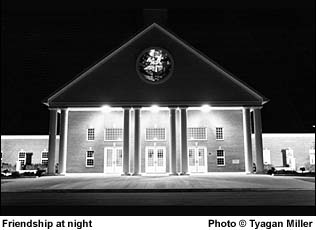In
September 1996, I began a photographic exploration of Friendship
Missionary Baptist Church-an inner city, African American congregation
located in Indianapolis, Indiana. I had become interested in
African American spiritual life when I was a teacher in an alternative
high school for
urban high-risk youth. It seemed to me that if my students'
families were struggling effectively against the hardships of
inner city living, they were also deeply connected to the life
of a church. I felt compelled to photograph and learn more about
this vital aspect of black culture.
 As
a white male having come of age in the era of civil rights,
nurtured by its consciousness and conscience, I cannot help
being convinced of the signal importance of the problem of race
in America. I am equally convinced that this issue deserves
our constant and enduring attention. Covenant: Living in the
Presence of God is an attempt to document one facet of this
enormous
subject by bearing witness to the complex life of a particular
community in a particular time and place.
As
a white male having come of age in the era of civil rights,
nurtured by its consciousness and conscience, I cannot help
being convinced of the signal importance of the problem of race
in America. I am equally convinced that this issue deserves
our constant and enduring attention. Covenant: Living in the
Presence of God is an attempt to document one facet of this
enormous
subject by bearing witness to the complex life of a particular
community in a particular time and place.
Gustave
Flaubert once said that "one does not choose one's subject matter;
one
submits to it." I began this documentary knowing little about
the world I would enter and possessing few points of reference
to guide me through it. At that time, I wished only to try to
understand how and why religious faith enabled young people
to succeed where other kinds of programs had failed them. What
I discovered at Friendship Missionary Baptist Church is a community
whose struggles against life's vagaries are transformed by the
shared vision of a perfect world beyond this one and guided
by a covenant they believe will lead them safely into it. In
the end, it has been the terms of their covenant - an affirmation
of life and the human spirit through fellowship,
knowledge, worship, and salvation - that I have let guide my
course through this project. Covenant has been and continues
to be for me a journey toward deeper understanding of a way
of life very different from my own.
 At
present Covenant comprises two hundred fifty photographs
made from over four thousand negatives. The first section, entitled
"Fellowship, Knowledge, Worship" records nearly four years of
Sunday and weekday church activities. The second section, entitled
"Advancing the Kingdom," describes the daily lives of church
members as they engage in missionary work around the city and
as they interact with their families, friends, and co-workers.
A third section, entitled "Dust of the Ground: Professions of
Doubt and Faith," explores the perceptions of the people who
know Friendship's realities best. In this series of environmental
portraits and accompanying interviews, church members talk about
a variety of topics, such as ecstasy (or as they put it, "getting
happy"); seeing the face of Jesus; the death of one's child;
being young, black, and saved; losing faith; miracles; racism
and brotherly love; having no fear; seeing an angel; and being
poor. As it progresses, the project will also include church
histories (Friendship was founded in 1917), as well as essays
on race, religion, renewal, and the city.
At
present Covenant comprises two hundred fifty photographs
made from over four thousand negatives. The first section, entitled
"Fellowship, Knowledge, Worship" records nearly four years of
Sunday and weekday church activities. The second section, entitled
"Advancing the Kingdom," describes the daily lives of church
members as they engage in missionary work around the city and
as they interact with their families, friends, and co-workers.
A third section, entitled "Dust of the Ground: Professions of
Doubt and Faith," explores the perceptions of the people who
know Friendship's realities best. In this series of environmental
portraits and accompanying interviews, church members talk about
a variety of topics, such as ecstasy (or as they put it, "getting
happy"); seeing the face of Jesus; the death of one's child;
being young, black, and saved; losing faith; miracles; racism
and brotherly love; having no fear; seeing an angel; and being
poor. As it progresses, the project will also include church
histories (Friendship was founded in 1917), as well as essays
on race, religion, renewal, and the city.
While Covenant is a record of things seen and heard in
unique circumstances, the view of life that underlies it reflects
the mutual aspiration of human beings everywhere. The pursuit
of a better life - whether it is sought on Earth or in a world
beyond this one - is our common heritage. Indeed, it is our
individual dreams of rescue from an existence defined by suffering
that motivate our most significant actions.
But Covenant also gives expression to issues of another
kind. The problem of race in America has informed the social
and economic tapestry of our national life for nearly three
hundred years. Because Covenant focuses on African American
religious experience and community life, we can view its images
and texts as an exploration into a number of meaningful topics
concerning race that do not take as their starting point a pejorative
portrayal of the black community. Despite their enduring focus
on a world beyond this one, the people who make up this community
pursue the elusive promise of the American dream. It is these
aspects of Covenant that I hope make it a helpful contribution
to the continuing dialogue about race relations in our time,
where we have a renewed opportunity to come to terms with the
historical specter of slavery.
Enter
the COVENANT photo gallery